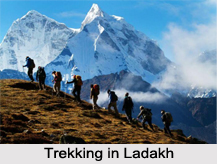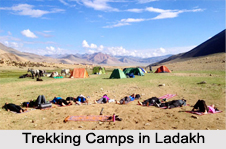 Trekking in Ladakh is one of the difficult treks for 10 days in the midst of snow and mountains in Northern Mountain Ranges. Ladakh- as a tourist place in India allure the leisure travelers for capturing the vibrant culture of the Indo-Tibetans in the different monasteries and market, ancient monasteries with ancient libraries and blue lakes with the presence of hills.
Trekking in Ladakh is one of the difficult treks for 10 days in the midst of snow and mountains in Northern Mountain Ranges. Ladakh- as a tourist place in India allure the leisure travelers for capturing the vibrant culture of the Indo-Tibetans in the different monasteries and market, ancient monasteries with ancient libraries and blue lakes with the presence of hills.
Ladakh region is the second home for the adventure lovers and trekkers. Ladakh is not only a leisure holiday destination in Jammu and Kashmir, it is also a trekker"s paradise because of the presence of the Pir Panjal Range and Greater Himalayan Mountain Range. It is far more beautiful and heavenly beyond civilization. These destinations can only be reached after several days of strenuous walk and combating the varying climate at different altitude. Trekking in Ladakh would take one to several unexplored destinations in the region that reveals the virgin territory at its best, just like a walk in paradise.
History and Nature in Ladakh
Ladakh in Jammu and Kashmir is secluded by the high peaks and further divulges the remote culture nestled in the colourful valleys along the river banks. It takes one to a natural gallery of ancient civilization that is dotted with the rock cut graphics depicting the Neolithic settlements, ancient monasteries that follow Buddhism that exhibit various forms of Indo-Tibetan culture and destinations, which is offering a panoramic view of streams and glaciers of the distant snow capped peaks and deep valleys.
Mountain Activities in Ladakh
Trekking in Ladakh has been one of the demanding mountain activities, pulling in global explorers to discover the unspoiled territory. The trekking tracks winds up to summits wherefrom one can enjoy a bird`s eye view of the Karakoram Range, which is aligned with several towering peaks like K2 Peak, Saser I, Saser II, Saser III, Saser IV , Saser V, Zanskar Himalaya and Nubra Valley. Stok Kangri summit trek is one of the demanding and challenging treks in the Ladakh region that offers such a celestial view of Karakoram Range.
Trans-Zanskar Trek
Trans-Zanskar Trek in the Ladakh region allows one to acquaint with the traditional environment and the Ladakh Monasteries Trek, which is one of the spiritual treks in the Ladakh region offering one to set on a sacred journey from cloister to cloister.
Rumbak Valley Trek in Ladakh
Rumbak Valley trek offers to see the wildlife and nature. Trailing deep into the Rumbak Valley one can encounter several endangered mountain species including Snow Leopard, Red Fox, Blue Sheep, Eurasian Bear and migratory birds. The popular Snow Leopard Trek that takes one into the Hemis National Park during the winters offers a trembling and nail-biting experience.
Chadar Trek in Ladakh
Chadar Trek is one of the winter treks in Ladakh. Here one needs to walk on the transparent snow. One needs to walk on the frozen river and combat the frigid climate.
Trekking Tracks in Ladakh
With the growth of tourism in Ladakh region in last twenty years, the trekking tracks in the Ladakh region have extended from the extreme north of India, to the Nubra Valley. Passing through the remote villages along the River Nubra trek to the Hunder Sand Dunes allows one to experience the undulated white and grey desert that is cut across by a narrow stream. Here it is dotted with animals like Bactrian Camels and Pashmina Goats. Down south of the Ladakh region, Tso Moriri Lake Trek (Tsomoriri Wetland Conservation Reserve) is another beautiful trek in Ladakh that brings forth a fairy story nature with a blue lake bounded by a rippled upland where the rare species of animals and birds are dominant in the wildlife sanctuaries.
Related Articles
Jammu and Kashmir
Districts of Jammu and Kashmir
Cities of Jammu and Kashmir
Indian Himalayan Regions
Himalayan Mountain Range



















